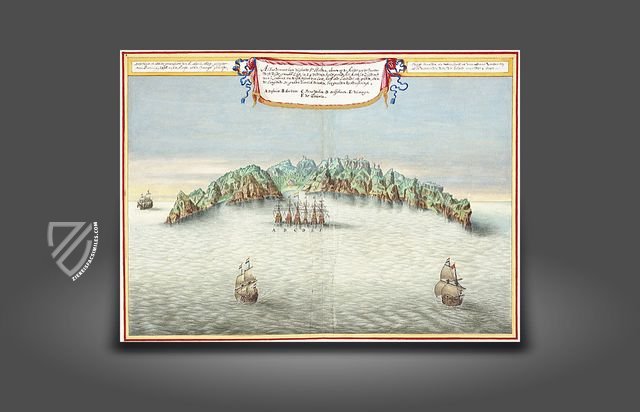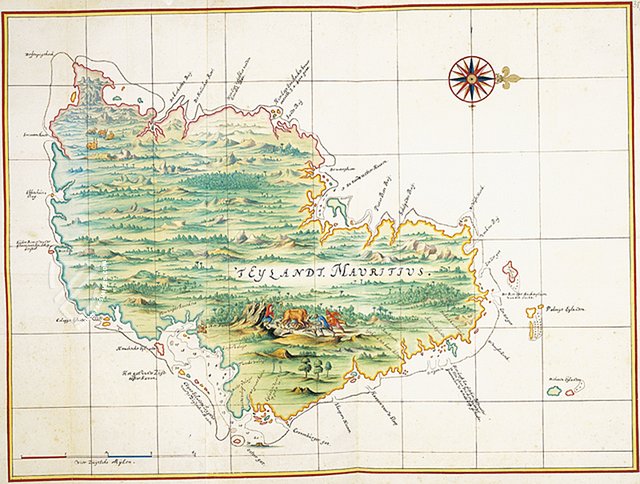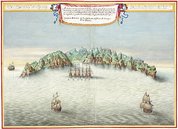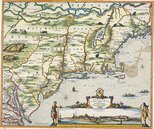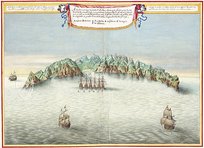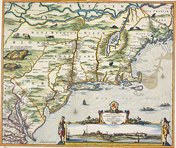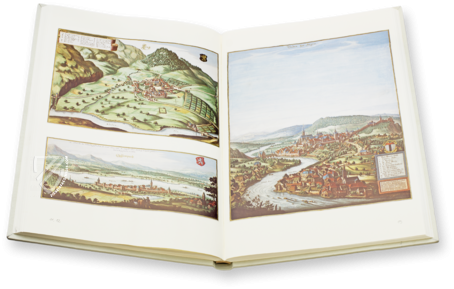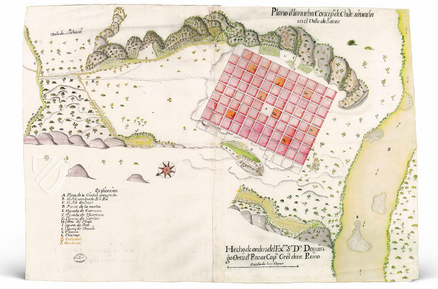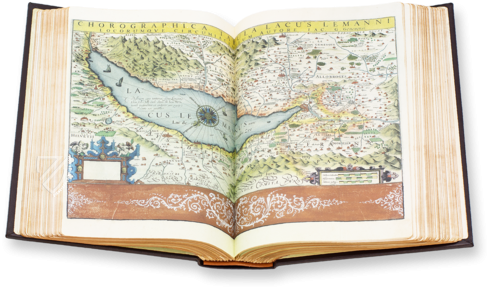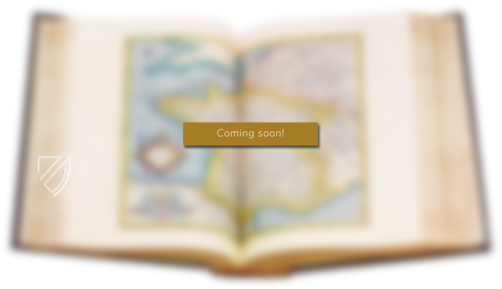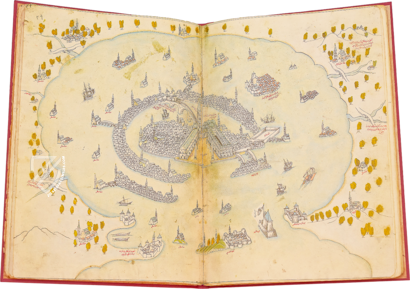Atlas Blaeu - Van der Hem
(over 10,000€)
Between 1662 and 1672, the Atlas Maior, the final version of the 1635 Atlas Novus by Joan Blaeu (1596–1673), was published in Amsterdam and in doing so, Blaeu brought the Golden Age of Dutch cartography to a splendid end. Depending on the translation, the work consists of 9–12 volumes comprising roughly 3,000 pages of text and 594 maps, topographical charts, landscapes, cityscapes detailing harbors and forts, seascapes with battling ships, and relevant information about local politics. A specially colored version was created at the behest of Laurens van der Hem (1621–78), a Dutch lawyer and map collector. His personal copy served as the backbone of a collection comprising 46-volumes of 2,400 maps, drawings, and charts in addition to other supplemental materials, making it by far the most extensive collection of its kind. The historic collection includes contributions from leading artists of the day from both within and without the Netherlands, many of whom personally visited the various locales they so splendidly depicted.
Atlas Blaeu - Van der Hem
The Golden Age of Dutch cartography, which was begun by Abraham Ortelius (1527–98) when his Theatrum Orbis Terrarum was posthumously published in 1570, came to its spectacular conclusion with the publication of the Atlas Maior, the final version of the 1635 Atlas Novus by Joan Blaeu (1596–1673), between 1662 and 1672 in Amsterdam. The largest and the most expensive publication of the entire 17th century. A special edition was created at the behest of Laurens van der Hem (1621–78), a Dutch lawyer and discerning connoisseur of maps and landscapes. The work not only contains maps, but topographical charts, landscapes, cityscapes detailing harbors and forts, seascapes with battling ships, and relevant information about local politics. It is one of the most highly coveted cartographic works in the world utilizing the most modern methods available at the time.
A Truly Epic Atlas
The final version of Blaeu’s atlas ranged between 9 and 12 volumes, depending on the translation, and included 594 maps and related illustrations adorning some 3,000 pages of text. Bearing the full title Atlas Maior, sive Cosmographia Blaviana, qua solum, salum, coelum, accuratissime describuntur or Grand Atlas or Blaeu's Cosmography, in which are Most Accurately Described Earth, Sea, and Heaven, this already extensive atlas was actually meant to be the first volume of an epic three-part work. The second installment was slated to address coasts, seas, and oceans while the third would map the heavens. However, a fire consumed the workshop in 1672, Joan Blaeu died the next year, and thus the second and third parts were never created. Nonetheless, what was created in the decades before 1672 continues to stand out as one of the most important and refined works of cartography in history. Van der Hem’s personal copy represents the backbone of his 46-volume-collection of 2,400 maps, drawings, and charts in addition to other supplemental materials, making it by far the most extensive collection of its kind. As a synthesis of the refined art of the Baroque period and the foremost methods of the Golden Age of Dutch cartography, this is a work second to none.
A Highly Coveted Personal Copy
Upon publication, an unembellished version was made available for purchase by price-conscious consumers, but Van der Hem had his copy hand-colored by Dirk Jansz van Santen (1637–1708). Van der Hem’s personal copy of the atlas even included a volume of secret maps created by the Dutch East India Company that were never part of the original publication. After being passed down to his wife and then his daughters, Van der Hem’s grandson sold the atlas at auction in 1730 for the price of 22,000 florins. The lucky buyer was no less than Prince Eugene of Savoy (1663–1736), a general of the Imperial army and one of the most successful military leaders of modern European history, who rose to the highest offices of the imperial court in Vienna through his victories in service to three Hapsburg emperors. He too had a keen interest in maps and landscapes. Also known as the Eugenius-Atlas as a result, it was through Prince Eugene that the incredible work came into the possession of the Imperial Library, precursor to the Austrian National Library in Vienna. Nearly destroyed in a fire in 1992, it has since been digitized and was added to the UNESCO Memory of the World Register in 2003.
The Labor of Many Hands
Many of the copperplates featured in the atlas were engraved by Joan Blaeu and his workshop, but dozens more had previously been acquired by his father Van der Hem himself helped to create the images Italy and Sicily. Nonetheless, it would be impossible for one man or even a few to have seen all these places and to record them in such detail. As such, Van der Hem’s massive collection of 2,400 maps and other images originate from a galaxy of Dutch artists including Andries Beeckman, Gaspar Bouttats, Jan Peeters I, Bonaventura Peeters the Elder, Jacques Callot, and Cornelis Gerritsz Decker. Other artists who recorded what they had seen in their travels also contributed to the work, they include Lambert Doomer, Jan Hackaert, Adriaen Matham, Roelant Savery, Willem Schellinks, and Reinier Nooms, also named as 'Zeeman'. Thus, Van der Helm’s personal copy, even more so than the original, is a blend of original creations, refined works already in existence, and a compilation of contributions by leading artists of the day.
Codicology
- Type
- Map on paper
- Origin
- Netherlands
- Date
- 1660–1678
- Epochs
- Style
- Genre
- Language
- Patron
- Laurens van der Hem
- Artist / School
- Joan Blaeu
Dirck Jansz Van Santen
Andries Beeckmann
Caspar Bouttats
Jacques Callot
Cornelis Dekker
Cornelis Jansz
Adrian Matham
Reinier Nooms, also known as Zeeman
Bonaventura Peeters I or II
Jan Peeters
Willem Schellinks
Seeger de Vries - Previous Owners
- Prince Eugene of Savoy
#1 Atlas Blaeu - Van der Hem
Language: English
(over 10,000€)
- Treatises / Secular Books
- Apocalypses / Beatus
- Astronomy / Astrology
- Bestiaries
- Bibles / Gospels
- Chronicles / History / Law
- Geography / Maps
- Saints' Lives
- Islam / Oriental
- Judaism / Hebrew
- Single Leaf Collections
- Leonardo da Vinci
- Literature / Poetry
- Liturgical Manuscripts
- Medicine / Botany / Alchemy
- Music
- Mythology / Prophecies
- Psalters
- Other Religious Books
- Games / Hunting
- Private Devotion Books
- Other Genres
- Afghanistan
- Armenia
- Austria
- Belgium
- Belize
- Bosnia and Herzegovina
- China
- Colombia
- Costa Rica
- Croatia
- Cyprus
- Czech Republic
- Denmark
- Egypt
- El Salvador
- Ethiopia
- France
- Germany
- Greece
- Guatemala
- Honduras
- Hungary
- India
- Iran
- Iraq
- Israel
- Italy
- Japan
- Jordan
- Kazakhstan
- Kyrgyzstan
- Lebanon
- Liechtenstein
- Luxembourg
- Mexico
- Morocco
- Netherlands
- Palestine
- Panama
- Peru
- Poland
- Portugal
- Romania
- Russia
- Serbia
- Spain
- Sri Lanka
- Sweden
- Switzerland
- Syria
- Tajikistan
- Turkey
- Turkmenistan
- Ukraine
- United Kingdom
- United States
- Uzbekistan
- Vatican City
- A. Oosthoek, van Holkema & Warendorf
- Aboca Museum
- Ajuntament de Valencia
- Akademie Verlag
- Akademische Druck- u. Verlagsanstalt (ADEVA)
- Aldo Ausilio Editore - Bottega d’Erasmo
- Alecto Historical Editions
- Alkuin Verlag
- Almqvist & Wiksell
- Amilcare Pizzi
- Andreas & Andreas Verlagsbuchhandlung
- Archa 90
- Archiv Verlag
- Archivi Edizioni
- Arnold Verlag
- ARS
- Ars Magna
- ArtCodex
- AyN Ediciones
- Azimuth Editions
- Badenia Verlag
- Bärenreiter-Verlag
- Belser Verlag
- Belser Verlag / WK Wertkontor
- Benziger Verlag
- Bernardinum Wydawnictwo
- BiblioGemma
- Biblioteca Apostolica Vaticana (Vaticanstadt, Vaticanstadt)
- Bibliotheca Palatina Faksimile Verlag
- Bibliotheca Rara
- Boydell & Brewer
- Bramante Edizioni
- Bredius Genootschap
- Brepols Publishers
- British Library
- C. Weckesser
- Caixa Catalunya
- Canesi
- CAPSA, Ars Scriptoria
- Caratzas Brothers, Publishers
- Carus Verlag
- Casamassima Libri
- Centrum Cartographie Verlag GmbH
- Chavane Verlag
- Christian Brandstätter Verlag
- Circulo Cientifico
- Club Bibliófilo Versol
- Club du Livre
- CM Editores
- Collegium Graphicum
- Collezione Apocrifa Da Vinci
- Comissão Nacional para as Comemorações dos Descobrimentos Portugueses
- Coron Verlag
- Corvina
- CTHS
- D. S. Brewer
- Damon
- De Agostini/UTET
- De Nederlandsche Boekhandel
- De Schutter
- Deuschle & Stemmle
- Deutscher Verlag für Kunstwissenschaft
- DIAMM
- Droz
- E. Schreiber Graphische Kunstanstalten
- Ediciones Boreal
- Ediciones Grial
- Ediclube
- Edições Inapa
- Edilan
- Editalia
- Edition Deuschle
- Edition Georg Popp
- Edition Leipzig
- Edition Libri Illustri
- Editiones Reales Sitios S. L.
- Éditions de l'Oiseau Lyre
- Editions Medicina Rara
- Editorial Casariego
- Editorial Mintzoa
- Editrice Antenore
- Editrice Velar
- Edizioni Edison
- Egeria, S.L.
- Eikon Editores
- Electa
- Emery Walker Limited
- Enciclopèdia Catalana
- Eos-Verlag
- Ephesus Publishing
- Ernst Battenberg
- Eugrammia Press
- Extraordinary Editions
- Fackelverlag
- Facsimila Art & Edition
- Facsimile Editions Ltd.
- Facsimilia Art & Edition Ebert KG
- Faksimile Verlag
- Feuermann Verlag
- Folger Shakespeare Library
- Franco Cosimo Panini Editore
- Friedrich Wittig Verlag
- Fundación Hullera Vasco-Leonesa
- G. Braziller
- Gabriele Mazzotta Editore
- Gebr. Mann Verlag
- Gesellschaft für graphische Industrie
- Getty Research Institute
- Giovanni Domenico de Rossi
- Giunti Editore
- Graffiti
- Grafica European Center of Fine Arts
- Guido Pressler
- Guillermo Blazquez
- Gustav Kiepenheuer
- H. N. Abrams
- Harrassowitz
- Harvard University Press
- Helikon
- Hendrickson Publishers
- Henning Oppermann
- Herder Verlag
- Hes & De Graaf Publishers
- Hoepli
- Holbein-Verlag
- Houghton Library
- Hugo Schmidt Verlag
- Idion Verlag
- Il Bulino, edizioni d'arte
- ILte
- Imago
- Insel Verlag
- Insel-Verlag Anton Kippenberger
- Instituto de Estudios Altoaragoneses
- Instituto Nacional de Antropología e Historia
- Introligatornia Budnik Jerzy
- Istituto dell'Enciclopedia Italiana - Treccani
- Istituto Ellenico di Studi Bizantini e Postbizantini
- Istituto Geografico De Agostini
- Istituto Poligrafico e Zecca dello Stato
- Italarte Art Establishments
- Jan Thorbecke Verlag
- Johnson Reprint Corporation
- Josef Stocker
- Josef Stocker-Schmid
- Jugoslavija
- Karl W. Hiersemann
- Kasper Straube
- Kaydeda Ediciones
- Kindler Verlag / Coron Verlag
- Kodansha International Ltd.
- Konrad Kölbl Verlag
- Kurt Wolff Verlag
- La Liberia dello Stato
- La Linea Editrice
- La Meta Editore
- Lambert Schneider
- Landeskreditbank Baden-Württemberg
- Leo S. Olschki
- Les Incunables
- Liber Artis
- Library of Congress
- Libreria Musicale Italiana
- Lichtdruck
- Lito Immagine Editore
- Lumen Artis
- Lund Humphries
- M. Moleiro Editor
- Maison des Sciences de l'homme et de la société de Poitiers
- Manuscriptum
- Martinus Nijhoff
- Maruzen-Yushodo Co. Ltd.
- MASA
- Massada Publishers
- McGraw-Hill
- Metropolitan Museum of Art
- Militos
- Millennium Liber
- Müller & Schindler
- Nahar - Stavit
- Nahar and Steimatzky
- National Library of Wales
- Neri Pozza
- Nova Charta
- Oceanum Verlag
- Odeon
- Orbis Mediaevalis
- Orbis Pictus
- Österreichische Staatsdruckerei
- Oxford University Press
- Pageant Books
- Parzellers Buchverlag
- Patrimonio Ediciones
- Pattloch Verlag
- PIAF
- Pieper Verlag
- Plon-Nourrit et cie
- Poligrafiche Bolis
- Presses Universitaires de Strasbourg
- Prestel Verlag
- Princeton University Press
- Prisma Verlag
- Priuli & Verlucca, editori
- Pro Sport Verlag
- Propyläen Verlag
- Pytheas Books
- Quaternio Verlag Luzern
- Reales Sitios
- Recht-Verlag
- Reichert Verlag
- Reichsdruckerei
- Reprint Verlag
- Riehn & Reusch
- Roberto Vattori Editore
- Rosenkilde and Bagger
- Roxburghe Club
- Salerno Editrice
- Saltellus Press
- Sandoz
- Sarajevo Svjetlost
- Schöck ArtPrint Kft.
- Schulsinger Brothers
- Scolar Press
- Scrinium
- Scripta Maneant
- Scriptorium
- Shazar
- Siloé, arte y bibliofilia
- SISMEL - Edizioni del Galluzzo
- Sociedad Mexicana de Antropología
- Société des Bibliophiles & Iconophiles de Belgique
- Soncin Publishing
- Sorli Ediciones
- Stainer and Bell
- Studer
- Styria Verlag
- Sumptibus Pragopress
- Szegedi Tudomànyegyetem
- Taberna Libraria
- Tarshish Books
- Taschen
- Tempus Libri
- Testimonio Compañía Editorial
- Thames and Hudson
- The Clear Vue Publishing Partnership Limited
- The Facsimile Codex
- The Folio Society
- The Marquess of Normanby
- The Richard III and Yorkist History Trust
- Tip.Le.Co
- TouchArt
- TREC Publishing House
- TRI Publishing Co.
- Trident Editore
- Tuliba Collection
- Typis Regiae Officinae Polygraphicae
- Union Verlag Berlin
- Universidad de Granada
- University of California Press
- University of Chicago Press
- Urs Graf
- Vallecchi
- Van Wijnen
- VCH, Acta Humaniora
- VDI Verlag
- VEB Deutscher Verlag für Musik
- Verlag Anton Pustet / Andreas Verlag
- Verlag Bibliophile Drucke Josef Stocker
- Verlag der Münchner Drucke
- Verlag für Regionalgeschichte
- Verlag Styria
- Vicent Garcia Editores
- W. Turnowski Ltd.
- W. Turnowsky
- Waanders Printers
- Wiener Mechitharisten-Congregation (Wien, Österreich)
- Wissenschaftliche Buchgesellschaft
- Wissenschaftliche Verlagsgesellschaft
- Wydawnictwo Dolnoslaskie
- Xuntanza Editorial
- Zakład Narodowy
- Zollikofer AG

